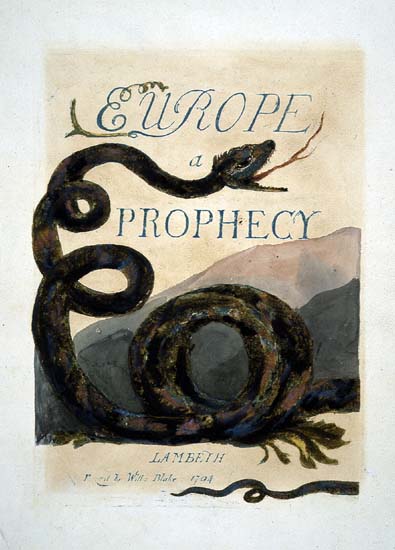 |
| Glasgow Library Europe Title Plate |
In illustrating Europe, A Prophecy Blake deviated from the text in several instances. He choose to focus attention on disasters which may befall mankind either as a result of his own decisions or because of circumstances beyond his control. In A Blake Dictionary, Damon names the full page illustrations Famine and Plague, and the Frontispiece illustration Ancient of Days showing the limits being set for man's activity. He mentions also images showing Treachery, Cruelty, War, Blighted Harvest and Imprisonment.
The narrative of the book places the historical events of Blake's own times into the structure of Blake's myth, but the illustrations show calamities which may plague mankind in any time or place. We see that man is a victim as a consequence of living in uncaring nature within a political structure which is imposed upon him.
Famine
Fear
Power
Plague
Pestilence
Fire
Treachery
Limitation
Cycles of Revolution
Mildew, Blighted Harvest
Imprisonment
Cruelty
War
In his own city, London, around the time when this poem was being written Blake observed food shortages, military conscription, imprisonment for sedition, loyalty oaths, restrictions on assembly, and failures of Parliament and King to protect the citizens. In the previous century London had experienced the Black Plague and devastating Great Fire of London. Blake used the illustrations to emphasize the precarious situation in which mankind exists.
From Blake's Apocalypse by Harold Bloom,
"In this unresolved intensity the most audacious poem Blake had yet written arrives at the the most inconclusive of his conclusions. The nightmare of history has been vividly exposed, but no cure for bad dreams has been suggested." (Page 161)
.
4 comments:
how timely... I wish I were better at reading and understanding Blake's words... any chance you could write a line-by-line note post? or link to one? maybe for the "Plague" section? I'm poking around on the interweb, crawling down more & more rabbitholes...
much love to you, m'dear!
Susan J
hmmm... maybe "Plague" isn't a section with words, just the one engraving you linked to? I tried reading the "book" pdf you linked to, got just about nowhere, searched it for the word "plague" and found only one occurrence:
"Shadows of men in fleeting bands upon the winds
Divide the heavens of Europe;
Till Albion's Angel, smitten with his own plagues, fled with his bands.
The cloud bears hard on Albion's shore,
Fill'd with immortal Demons of futurity:
In council gather the smitten Angels of Albion;
The cloud bears hard upon the council−house, down rushing
On the heads of Albion's Angels."
Any idea what that means....? I know that Albion is England....
https://www.historic-uk.com/HistoryUK/HistoryofEngland/The-Great-Plague/
"Incubation took a mere four to six days and when the plague appeared in a household, the house was sealed, thus condemning the whole family to death! These houses were distinguished by a painted red cross on the door and the words, ‘Lord have mercy on us’. At night the corpses were brought out in answer to the cry,’ Bring out your dead’, put in a cart and taken away to the plague pits. One called the Great Pit was at Aldgate in London and another at Finsbury Fields."
Blake's picture is meant to show the suffering and the sorrow. The wall behind the dying woman is inscribed with the words which were to be painted on the door. The bell-ringer announced that bodies were to be picked up.
The text does not present the disasters which are shown in the images although it is not unrelated to political situations which cause suffering.
The passage which you quote is said to refer to conflicts plaguing the nations of Europe where internal dissensions spread to other 'heavens' and pressures are felt throughout the society.
Blake couldn't write about the king and the prime minister and the parliament, or about the navy and Napoleon. But then he didn't really want to be specific. He wanted to fit the events taking place around him into pattern of ever repeating history.
You might say that Blake was giving a warning. The text presents it one way and the pictures present it another. However in Europe he leaves a wide gap between what he presents and what he wants his reader to understand. I don't think I am capable of crossing that gap.
thanks so much for this, Ellie - fascinating!!!
"... a wide gap between what he presents and what he wants his reader to understand. I don't think I am capable of crossing that gap"
sounds like the Bible! If we get in the Spirit, God will tell us directly :-)
Post a Comment